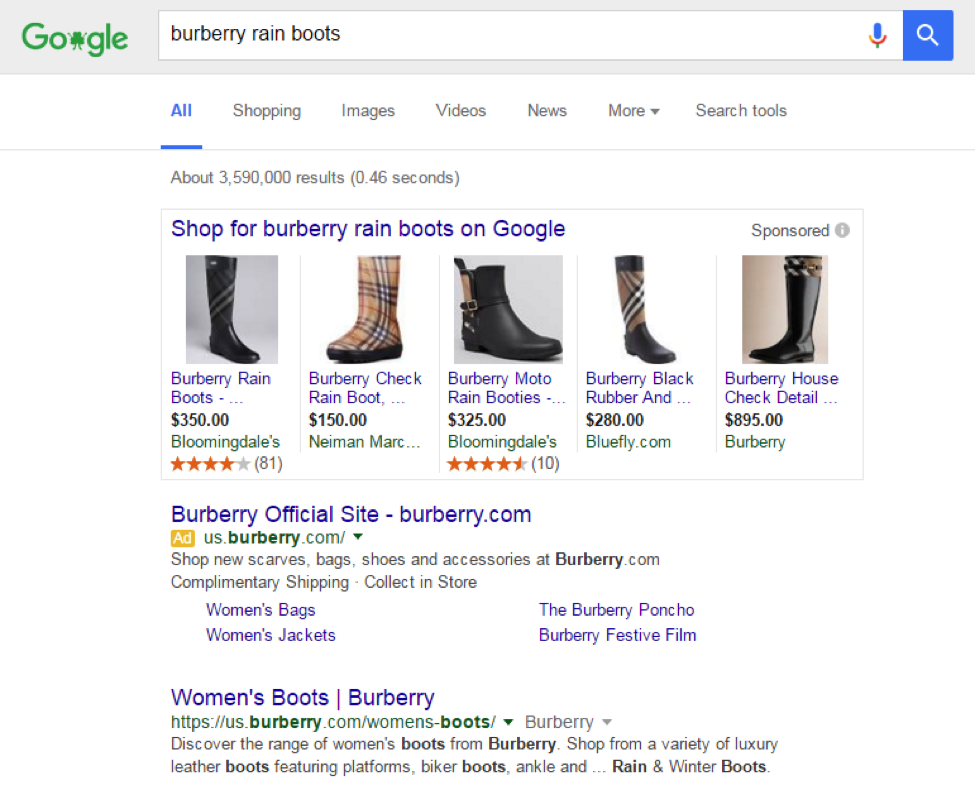What the New Google SERP Layout Means to Your PPC Ad Strategy
At the end of February, Google announced a big change coming to its search results – PPC ads on the right side of search results pages would be no more. Aside from an aesthetic change, this impacts advertisers’ strategies and budgets. The new layout will delete the right side ads, allowing only four ads at the top and/or at the bottom (three ads max). So, each SERP will host seven or less ads.
There are two exceptions:
- Product Listing Ad (PLA) boxes, now called a Shopping Campaign
- Ads shown in the Knowledge Graph
Super commercial searches, such as “organic dog treats in San Diego,” would allow a fourth ad above the search results. Commercial searches, according to Google, are those that carry the intent to purchase. Consider the following example:
The top “boxed” ads are considered commercial and so are found above the ad and the website. It’s not only advantageous for advertisers, but for consumers as well. Google has the right idea – if a person is searching for, say, Burberry rain boots, it’s safe to “assume” they are searching for them because they are interested in purchasing a pair. Burberry gets its popular boots shown at the top of the SERP and the consumer sees immediate results, making it easier and quicker to make a purchase.
What does this change mean to advertisers?
To put it plainly, there are less available spots “above the fold” for advertisements, which will lead to more competitive prices (up, up, up), although that has not been seen quite yet. Advertisers need to revisit ad strategies to:
- Manage the budget. Does more money need to be allotted for your ad campaign to make up for the cost difference? Can your company afford to advertise in this way? Could your budget go further on other channels? It’s important to understand your budget and how you can get the best viewership for your dollar.
- Evaluate the channel. Will continuing to use Google SERP be advantageous for you or your client? Smaller brands may have to make big changes if the budget doesn’t support the current strategy. Understanding the different channels available for you or your client and strategizing the usage could save you green, and headaches.
- Update the content. How can you make your content stand out? With less ad space on the SERP, your content needs to shine brighter than the rest. Shinier content can include: Video, infographics, answering customer questions, and branded content.
Track the success of each new piece of content on the new layout and find ways to reproduce that success as well as revisiting the content that fell flat and trying again. While visiting your content, one of the most important aspects to consider is your audience. Is SERP advertising the best way to reach your audience? What does your audience enjoy? What are their hobbies and interests? Updating content, evaluating the channel, and managing the budget won’t mean a thing if your audience isn’t using the channel. You can check out our PPC advertising services to learn more or get some personalized advice.
Don’t Forget About Social Media
Google’s update will also lead you to revisiting your social media presence. Social media becomes more important as the opportunities for engaging customers becomes slimmer through organic search. Not only does it provide more vehicles to share your content, it will help make customers more aware of your brand, which will lead to organic searches from them in the future. Transitioning them from window shoppers to consumers through social media can be easy and inexpensive:
- Interacting directly with potential customers. Respond to positive reviews or comments. Your customer will appreciate it and, most of all, remember it the next time they need what you’re selling.
- Interacting with current customers’ questions and issues. This improves your authority on the subject and earns trust. Trustworthy companies are successful companies. Earn their trust and you earn a lifelong customer.
- Sponsored ads. Shell out some money to get your ads noticed. Not just on SERP but on social media as well. Social media such as Facebook is “pay to play.” To get your ads in front of new consumers, you have to budget for some eyeballs to see your ads.
Consumers are on social media much more than they are on your website or researching your brand, so you need to not only get the content in front of them, but cater it to your specific audience or audiences. Creating and implementing that content is just the start. Good customer service needs to back up your products or services in order to get a positive perception out there. Many people love sharing brands they are passionate about, so make them passionate about yours!
Sum It Up For Me
The new Google SERP layout is a big change, mostly with the amount of ads allowed on a search page. This will likely send the price for these spots skyward, even if your budget doesn’t move. Revisit your budget, research advertising channels and update your content. Most of all, keep your audience in mind. Always. Go where your audience goes, and revisit your brand if your audience isn’t buying it.
Have you seen an impact in your traffic or paid advertising metrics because of the change? Let us know how it affected you in the comment section below.









